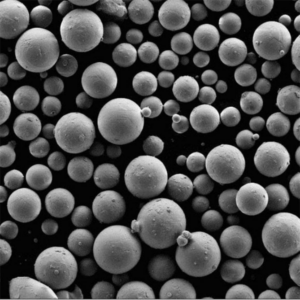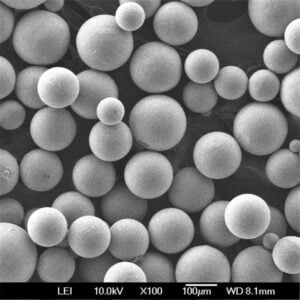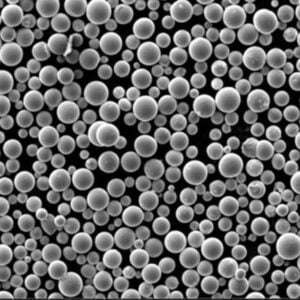
AlCrFeCoNiCu Powder: The Ultimate Guide for 2025
Low MOQ
Provide low minimum order quantity to meet different needs.
OEM & ODM
Provide customized products and design services to meet unique customer needs.
Adequate Stock
Ensure fast order processing and provide reliable and efficient service.
Customer Satisfaction
Provide high quality products with customer satisfaction at the core.
share this article
Table of Contents
Overview
AlCrFeCoNiCu powder is a cutting-edge High-Entropy Alloy (HEA) known for its exceptional strength, corrosion resistance, wear resistance, and thermal stability. This alloy is widely used in aerospace, industrial coatings, energy, and high-performance additive manufacturing applications due to its unique composition, which includes Aluminum (Al), Chromium (Cr), Iron (Fe), Cobalt (Co), Nickel (Ni), and Copper (Cu) in near-equiatomic proportions.
Composition and Role of Elements in AlCrFeCoNiCu
✔ Aluminum (Al): Enhances oxidation resistance and strength
✔ Chromium (Cr): Provides excellent corrosion resistance
✔ Iron (Fe): Contributes to structural stability and toughness
✔ Cobalt (Co): Increases wear resistance and thermal stability
✔ Nickel (Ni): Improves high-temperature strength and ductility
✔ Copper (Cu): Enhances electrical and thermal conductivity
Key Properties
✔ High hardness and wear resistance, making it perfect for aerospace and industrial coatings
✔ Superior corrosion resistance, ensuring durability in marine and chemical environments
✔ Exceptional thermal stability, making it suitable for high-temperature applications
✔ Optimized for Additive Manufacturing (AM), including Laser Powder Bed Fusion (LPBF) and Electron Beam Melting (EBM)
This guide will cover:
- Best AlCrFeCoNiCu powder for 3D printing
- How to choose the right AlCrFeCoNiCu powder
- Top suppliers of AlCrFeCoNiCu powder
- Properties and industrial applications
- Production methods and cost analysis
- Comparison of gas-atomized vs. plasma-atomized AlCrFeCoNiCu powder
Best AlCrFeCoNiCu Powder for 3D Printing in 2025
Why AlCrFeCoNiCu Powder is Ideal for Additive Manufacturing?
- High strength and wear resistance, making it perfect for aerospace and industrial coatings
- Excellent printability, reducing defects in LPBF and EBM processes
- Outstanding oxidation and corrosion resistance, making it suitable for marine and chemical applications
- Superior fatigue resistance, ensuring durability in high-stress environments
Key Factors for Selecting AlCrFeCoNiCu Powder for 3D Printing
- Spherical morphology for optimal powder flowability
- Controlled particle size distribution enhances printability and layer adhesion
- Low oxygen & impurity levels prevent powder degradation
- Consistent mechanical properties post-processing
Comparison for Different 3D Printing Technologies
| 3D Printing Technology | Recommended AlCrFeCoNiCu Powder | Advantages | Challenges |
|---|---|---|---|
| Laser Powder Bed Fusion (LPBF) | Gas-atomized spherical powder (15-45µm) | High precision, fine details | Requires optimized laser parameters |
| Electron Beam Melting (EBM) | Plasma-atomized powder (45-105µm) | Low residual stress | Limited material availability |
| Direct Energy Deposition (DED) | Gas-atomized powder (50-150µm) | Large-scale part production | Requires post-processing |
| Binder Jetting | Irregular or spherical powder (30-80µm) | High-speed production | Requires sintering & infiltration |
For high-performance 3D printing applications, Met3DP’s gas-atomized AlCrFeCoNiCu powder is the best choice. Learn more about Met3DP’s high-quality metal powders.
How to Choose the Right AlCrFeCoNiCu Powder
Selecting the best AlCrFeCoNiCu powder depends on several factors, including particle size distribution, atomization process, and application-specific requirements.
1. Particle Size Distribution (PSD)
- Fine powders (15-45µm) → Best for LPBF (Laser Powder Bed Fusion)
- Medium powders (45-105µm) → Suitable for EBM & Binder Jetting
- Coarse powders (50-150µm) → Used in DED (Direct Energy Deposition)
2. Powder Morphology
- Spherical Powder → Best for 3D printing and powder bed fusion technologies
- Irregular Powder → Suitable for Binder Jetting & Sintering
3. Atomization Process
- Gas-Atomized Powder → High purity, excellent flowability, best for 3D printing
- Plasma-Atomized Powder → Ultra-high purity, best for aerospace and industrial applications
For high-precision 3D printing, Met3DP’s gas-atomized AlCrFeCoNiCu powder is the best choice. Contact Met3DP for more details.
Production Methods
The production method of AlCrFeCoNiCu powder plays a crucial role in determining its particle shape, purity, and mechanical properties, which directly impact its performance in additive manufacturing, aerospace, and industrial applications.
Comparison of Production Methods
| Production Method | Particle Shape | Purity | Best Applications | Cost |
|---|---|---|---|---|
| Gas Atomization (GA) | Spherical | High | 3D Printing, Aerospace, Industrial Coatings | Medium |
| Plasma Atomization (PA) | Highly Spherical | Ultra High | High-End AM, Aerospace, Wear-Resistant Coatings | High |
| Vacuum Induction Melting + Gas Atomization (VIGA) | Spherical | Ultra-High | Aerospace Components, High-Precision AM | Very High |
| PREP (Plasma Rotating Electrode Process) | Highly Spherical | Ultra-Pure | High-Performance Wear-Resistant Components | Very High |
1. Gas Atomization (GA)
Process:
- Molten AlCrFeCoNiCu alloy is atomized into fine droplets using high-pressure inert gas (argon or nitrogen), which rapidly solidifies into spherical powder particles.
Advantages:
✔ Highly spherical morphology, improving flowability and printability
✔ Low oxygen content, reducing oxidation defects
✔ Excellent particle size distribution, ensuring consistent layer deposition in additive manufacturing
Best for: Laser Powder Bed Fusion (LPBF), Electron Beam Melting (EBM), and Direct Energy Deposition (DED)
2. Plasma Atomization (PA)
Process:
- AlCrFeCoNiCu wire is fed into a high-energy plasma torch, melting it into fine droplets that form highly spherical powder particles.
Advantages:
✔ Perfect spherical shape, ensuring superior flowability in powder bed fusion processes
✔ Ultra-high purity, making it ideal for aerospace and high-performance industrial applications
✔ Minimal satellite particles, leading to superior print quality
Disadvantages:
✖ Higher production costs
✖ Limited scalability for large-scale production
Best for: High-performance aerospace components and wear-resistant coatings
3. PREP (Plasma Rotating Electrode Process)
Process:
- A rotating AlCrFeCoNiCu electrode is melted by plasma, while centrifugal force atomizes the molten material into fine spherical particles.
Advantages:
✔ Ultra-high purity, with minimal contamination
✔ Highly spherical morphology, leading to excellent flowability
✔ Minimal porosity, making it ideal for high-performance applications
Disadvantages:
✖ Very high cost
✖ Limited scalability
Best for: High-temperature industrial coatings, aerospace turbine blades, and wear-resistant components
For high-quality additive manufacturing, Met3DP’s gas-atomized AlCrFeCoNiCu powder is the best choice. Explore Met3DP’s powder production solutions.
Cost Analysis in 2025
The cost of AlCrFeCoNiCu powder is influenced by several factors, such as production method, particle morphology, purity level, and application-specific requirements.
Factors Affecting Cost
- Production Method – PREP and plasma-atomized powders are the most expensive, while gas-atomized powders offer a more balanced cost-performance ratio.
- Particle Shape – Spherical powders (for AM) are more expensive than irregular powders.
- Purity Level – Higher purity = Higher cost.
- Market Demand – Increased demand from aerospace, industrial coatings, and high-performance applications influences pricing.
Estimated Price Ranges
| Powder Type | Price (USD/kg) | Best For |
|---|---|---|
| Gas-Atomized AlCrFeCoNiCu Powder | 700−700 – 700−1,100 | 3D Printing, Aerospace, Industrial Coatings |
| Plasma-Atomized AlCrFeCoNiCu Powder | 1,600−1,600 – 1,600−2,900 | Aerospace, High-Temperature Coatings |
| PREP AlCrFeCoNiCu Powder | 3,800−3,800 – 3,800−5,800 | High-Purity Industrial Coatings and High-Performance Components |
For cost-effective, high-quality AlCrFeCoNiCu powder, Met3DP provides precision-engineered solutions tailored to industrial needs. Contact Met3DP for pricing and availability.
FAQ
Q1: What is the best AlCrFeCoNiCu powder for 3D printing?
Gas-atomized spherical AlCrFeCoNiCu powder is optimal for LPBF, EBM, and DED due to its excellent flowability and low oxygen content.
Q2: How does AlCrFeCoNiCu compare to traditional stainless steel alloys?
AlCrFeCoNiCu offers superior wear resistance, corrosion resistance, and high-temperature stability, whereas stainless steels like 316L are more cost-effective but have lower mechanical properties.
Q3: Can AlCrFeCoNiCu powder be used for aerospace applications?
Yes, AlCrFeCoNiCu is widely used in aerospace for turbine blades, jet engines, and high-temperature structural components due to its high strength and oxidation resistance.
Q4: Where can I buy high-quality AlCrFeCoNiCu powder?
Met3DP is a leading supplier of gas-atomized AlCrFeCoNiCu powder, optimized for 3D printing and high-performance applications. Contact Met3DP today!
Conclusion
AlCrFeCoNiCu powder is an exceptional high-performance High-Entropy Alloy (HEA) for aerospace, industrial coatings, additive manufacturing, and high-temperature applications. Choosing the right powder type, production method, and supplier ensures optimal performance and reliability.
Why Choose Met3DP’s AlCrFeCoNiCu Powder?
✅ Industry-leading gas atomization technology
✅ High-purity spherical powders for additive manufacturing
✅ Reliable supply chain & global distribution
For high-performance AlCrFeCoNiCu powder, Met3DP provides state-of-the-art solutions tailored to industrial demands.
Want to learn more or get a quote? Contact Met3DP today!
Get Latest Price
About Met3DP
Product Category
HOT SALE
CONTACT US
Any questions? Send us message now! We’ll serve your request with a whole team after receiving your message.

Metal Powders for 3D Printing and Additive Manufacturing
COMPANY
PRODUCT
cONTACT INFO
- Qingdao City, Shandong, China
- [email protected]
- [email protected]
- +86 19116340731








